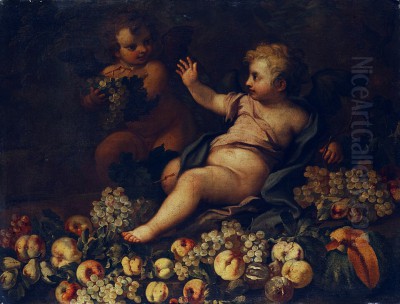
Giovanni Paolo Castelli, known affectionately and professionally by the nickname "lo Spadino," stands as a significant figure in the rich tapestry of Italian Baroque art. Active primarily in Rome during the late 17th and early 18th centuries, Castelli carved a niche for himself as a master of still life painting, a genre referred to in Italian as natura morta (literally "dead nature"). His life, spanning from 1659 to 1730, coincided with a period of flourishing artistic activity in the papal city, and his work contributes a distinct voice to the visual culture of his time. He was not an isolated artist but part of a celebrated family dedicated to the art of painting.
Biographical Context and Family Ties
Confirmed records place Giovanni Paolo Castelli's birth in 1659 and his death in 1730. He was born and worked predominantly in Rome, a bustling center of artistic patronage and innovation. The Castelli family was well-established within the Roman art scene, known particularly for their specialization in still life compositions. Giovanni Paolo was notably associated with his brother, Bartolomeo Castelli, who is often referred to as "the Elder Spadino" to distinguish him from Giovanni Paolo and potentially other family members.
This familial connection was central to their artistic practice. The Castelli brothers often worked in close proximity, sharing stylistic affinities while possibly developing individual nuances. The tradition extended to the next generation, with Giovanni Paolo's son, also named Bartolomeo Castelli (distinguished as "the Younger Spadino"), continuing the family's artistic legacy. This dynastic focus on natura morta established the Castelli name as synonymous with high-quality still life painting in Rome.
The Origin of "Lo Spadino"
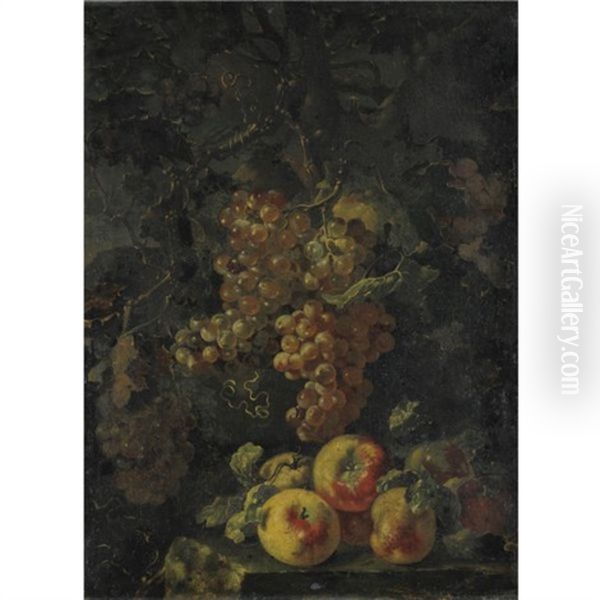
The nickname "lo Spadino," meaning "the little sword" or "little dagger," is intrinsically linked to Giovanni Paolo Castelli's artistic identity. According to art historical accounts derived from the provided information, this moniker originated from his habit of using a small dagger, perhaps as a tool in his studio or, more intriguingly, as a motif or element within his signature on his canvases. Some sources suggest evidence of this can be found in stamps or signatures on his works, adding a layer of personal branding to his artistic output. This distinctive nickname helped differentiate him within the bustling Roman art world and remains a key identifier for the artist today.
Artistic Formation and Influences
While details of his earliest training remain somewhat speculative, it is suggested that Giovanni Paolo Castelli may have spent time in the workshop of Abraham Brueghel, or possibly Abraham Grumuri (sources vary or may refer to related figures or workshops active in Rome). Regardless of direct tutelage, the influence of Abraham Brueghel, a Flemish painter active in Italy, is considered significant on Castelli's style. This connection points towards an absorption of Northern European precision combined with Italian Baroque sensibilities.
Castelli's artistic development was also shaped by other painters active in Rome. The influence of Carlo de Coninck is noted, suggesting an engagement with the broader currents of still life painting practiced in the city. Furthermore, his work shows affinities with the Dutch master Abraham van Beyeren, known for his opulent banquet pieces and detailed textures, and Christian Berrenten, a German painter also active in Italy. Within the Italian context, comparisons are drawn to Cristoforo Munari, another prominent still life specialist.
Of course, the most immediate artistic environment was his own family. Working alongside his brother Bartolomeo undoubtedly played a crucial role in shaping his technique and thematic choices. The family workshop likely fostered a shared visual language centered on the meticulous depiction of natural objects. His style also reflects the broader influence of the Baroque era's emphasis on drama, light, and realism, possibly absorbing lessons from the revolutionary use of chiaroscuro pioneered by Caravaggio, whose impact resonated throughout Roman painting circles. He was also a contemporary of other Roman still-life painters like Michelangelo Pace del Campidoglio, contributing to a vibrant local school focused on this genre.
The Art of Still Life: Style and Technique
Giovanni Paolo Castelli's reputation rests firmly on his mastery of natura morta. His paintings typically feature arrangements of fruits, vegetables, and flowers, sometimes accompanied by birds or other small elements of nature. A defining characteristic of his style is the directness of presentation; often, the objects are depicted against a simple, dark background, focusing the viewer's attention entirely on the textures, colors, and forms of the still life itself.
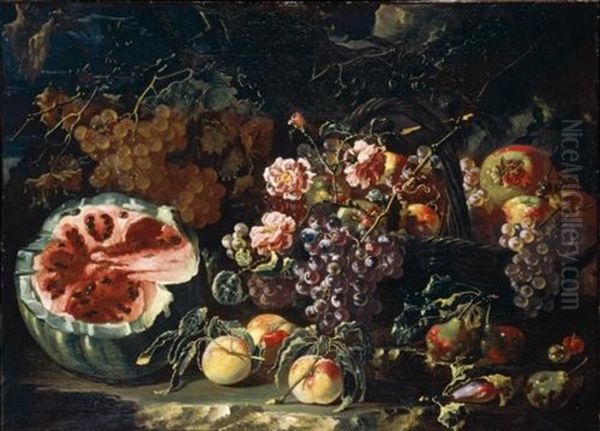
His handling of light and shadow is particularly noteworthy. Castelli employed chiaroscuro techniques effectively to give his subjects a tangible sense of volume and presence. Light often falls dramatically across the composition, highlighting the glistening skin of fruits, the delicate petals of flowers, or the reflective surfaces of objects like glass bowls. This skillful manipulation of light imbues his works with a sense of immediacy and realism.
Color is another key element of Castelli's art. He utilized a palette characterized by vivid and harmonious hues. The colors are applied with a sensitivity that captures the natural vibrancy of his subjects – the deep reds of peaches, the bright yellows of lemons, the rich greens of leaves. His brushwork often involved applying paint thickly (impasto) to convey the specific textures of different objects, from the rough skin of a melon to the smooth surface of a grape.
Detail and precision are hallmarks of his work. Castelli paid meticulous attention to rendering the unique characteristics of each item. Sources mention his ability to capture the subtle reflections on glass surfaces and even the specific textures involved in processes like biscuit making, suggesting a keen eye for observation and a high level of technical proficiency. This dedication to detail elevates his still lifes beyond mere decoration, inviting close contemplation of the natural world. His compositions, while often focused, demonstrate a strong sense of rhythm and balance, informed by an intuitive grasp of natural beauty, sometimes echoing the more elaborate environmental settings found in the works of Abraham Brueghel.
Representative Works
Several specific works exemplify Giovanni Paolo Castelli's artistic output and stylistic features:
Natura morta con frutta e uccelli (Still life with fruit and birds): This title suggests a typical composition for Castelli, combining fruit arrangements with elements of fauna, showcasing his ability to render diverse natural textures and forms within a single canvas.
Natura morta con pesche, limoni e fichi (Still life with peaches, lemons, and figs): This work is specifically noted for its depiction of fruit within a glass container, highlighting Castelli's skill in rendering transparency and reflection, key elements demonstrating technical virtuosity in still life painting. The interplay of light on both the fruit and the glass would be central to its effect.
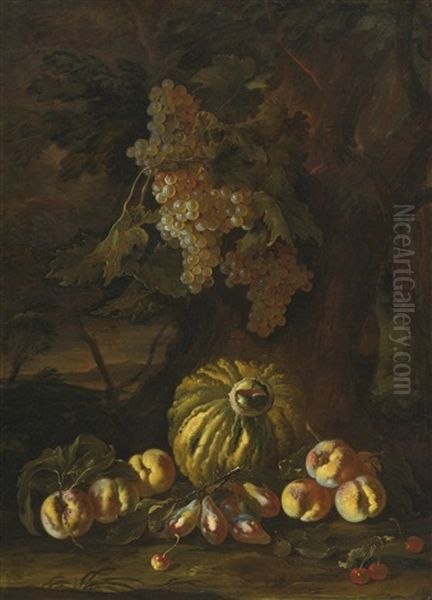
Peaches and Pears in Glass Bowl: Similar to the above, this title emphasizes the combination of fruit and glass. Such works allowed Castelli to explore the contrasts between the soft, organic forms of the fruit and the hard, reflective surface of the bowl, showcasing his mastery over different textures and light effects.
Natura morta con uva e mele (Still life with grapes and apples): Another example of his focus on common fruits, this work would likely display his characteristic use of vibrant color and dramatic lighting to bring the simple subject matter to life, emphasizing the plumpness of the grapes and the solid forms of the apples.
These examples, representative of his oeuvre, consistently demonstrate Castelli's commitment to the detailed, color-rich, and luminously rendered depiction of natural objects, solidifying his reputation within the natura morta genre.
A Family Affair: The Castelli Workshop
The Castelli family operated almost as a collective force in the Roman still life market. Giovanni Paolo's collaboration with his brother, Bartolomeo the Elder, was fundamental. While art historians might strive to distinguish their individual hands, the provided information emphasizes their shared dedication to the genre and likely a high degree of stylistic consistency emerging from their workshop. This familial approach ensured a continuity of style and quality associated with the Castelli name.
The continuation of this tradition by Giovanni Paolo's son, Bartolomeo the Younger, further cemented the family's legacy. This multi-generational focus on still life painting allowed for the refinement and transmission of specific techniques and compositional formulas, making the Castelli workshop a significant contributor to the development and popularity of natura morta in Rome over several decades.
Legacy and Appreciation
Giovanni Paolo Castelli's works were appreciated during his lifetime and continue to be recognized for their quality and historical importance. His paintings found their way into significant collections. Notably, works by him are held in institutions such as the Pinacoteca Capitolina in Rome and potentially the collections housed in the Palazzo Reale di Capodimonte in Naples (referenced as "Carlo li Palace" in the source material, likely indicating the Capodimonte, originally built by Charles VII of Naples).
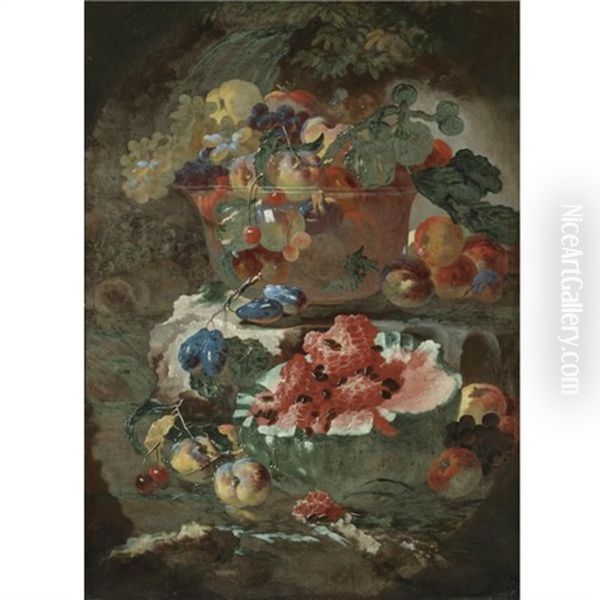
The enduring appeal and market value of his work are evidenced by examples such as a painting attributed to him being estimated at €5,000 to €8,000 at a European auction in 2019. This indicates a continued interest among collectors and institutions in acquiring works by this master of Roman still life. His contribution lies not only in the technical excellence of his paintings but also in his role within the Castelli family dynasty, which collectively enriched the tradition of still life painting in Italy during the Baroque period.
Conclusion
Giovanni Paolo Castelli, "lo Spadino," remains a compelling figure in Italian art history. As a key member of the Castelli painting family in Rome, he dedicated his career to the meticulous and vibrant depiction of natura morta. His works are characterized by their rich color, dramatic use of light and shadow, and extraordinary attention to detail, capturing the textures and forms of fruits, flowers, and other natural objects with remarkable skill. Influenced by both Italian and Northern European traditions, and working closely with his family members, Castelli developed a distinctive style that contributed significantly to the flourishing of still life painting in the Baroque era. His legacy endures through his captivating canvases, which continue to be admired in collections and appreciated for their technical brilliance and sensitive observation of the natural world.